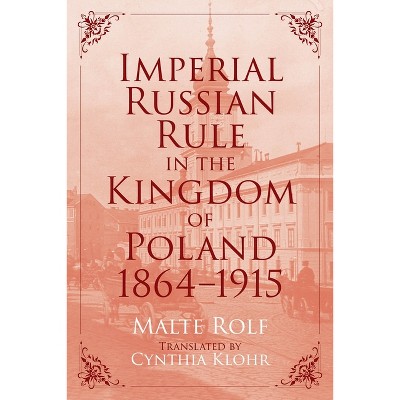Sponsored

Manufacturing a Socialist Modernity - (Russian and East European Studies) by Kimberly Elman Zarecor (Hardcover)
$65.00
In Stock
Eligible for registries and wish lists
Sponsored
About this item
Highlights
- Eastern European prefabricated housing blocks are often vilified as the visible manifestations of everything that was wrong with state socialism.
- About the Author: Kimberly Elman Zarecor is assistant professor of architecture at Iowa State University.
- 480 Pages
- History, Europe
- Series Name: Russian and East European Studies
Description
About the Book
The first comprehensive history of architectural practice and the emergence of prefabricated housing in the Eastern Bloc. Through discussions of individual architects and projects, as well as building typologies, professional associations, and institutional organization, Zarecor opens a rare window into the cultural and economic life of Eastern Europe during the early postwar period.Book Synopsis
Eastern European prefabricated housing blocks are often vilified as the visible manifestations of everything that was wrong with state socialism. For many inside and outside the region, the uniformity of these buildings became symbols of the dullness and drudgery of everyday life. Manufacturing a Socialist Modernity complicates this common perception. Analyzing the cultural, intellectual, and professional debates surrounding the construction of mass housing in early postwar Czechoslovakia, Zarecor shows that these housing blocks served an essential function in the planned economy and reflected an interwar aesthetic, derived from constructivism and functionalism, that carried forward into the 1950s. With a focus on prefabricated and standardized housing built from 1945 to 1960, Zarecor offers broad and innovative insights into the country's transition from capitalism to state socialism. She demonstrates that during this shift, architects and engineers consistently strove to meet the needs of Czechs and Slovaks despite challenging economic conditions, a lack of material resources, and manufacturing and technological limitations. In the process, architects were asked to put aside their individual creative aspirations and transform themselves into technicians and industrial producers. Manufacturing a Socialist Modernity is the first comprehensive history of architectural practice and the emergence of prefabricated housing in the Eastern Bloc. Through discussions of individual architects and projects, as well as building typologies, professional associations, and institutional organization, it opens a rare window into the cultural and economic life of Eastern Europe during the early postwar period.Review Quotes
A fascinating book . . . well researched . . . quite beautifully and masterfully laid out.-- "Slavic Review"
After World War II, all Czech architectural offices and building firms merged into a unified state apparatus, extending earlier experiments by Europe's most advanced architectural functionalists. This endeavor would later clash with the discourse of socialist realism imposed under the Soviets. Zarecor masterfully reconstructs the intense conflicts among architects caught between modern technology and nostalgic aesthetics as reflected in their designs and theoretical discourse.-- "Jean-Louis Cohen, New York University"
By the end of this book, a reader unfamiliar with Czechoslovak architectural history will never look at a panelak--the much maligned prefab apartment bloc of the socialist period--the same way again. . . . Zarecor brings to the book the eye of a trained architect, but also an ear for the politics of the time, and this is as much a study of policy-making and factional struggle as it is of design. On those grounds alone it should be read by anyone with an interest in Stalinism in Central Europe.-- "SEER"
From postwar modernist model housing developments in Kladno, Most, and Ostrava to the first panel+k at Gottwaldov, Manufacturing a Socialist Modernity explains in vivid detail and lucid prose how architecture and politics worked together--for better or for worse--to define Czechoslovakia's urban landscape in the Communist era.-- "Lewis H. Siegelbaum, Michigan State University"
Groundbreaking . . . Zarecor successfully describes the mechanism of architectural practice under the communist regime in Czechoslovakia between 1948 and 1961, convincingly rejects the notion that this practice was completely under political pressure and identifies a line of continuity with earlier efforts by the admired and politically 'innocent' inter-war generation of architects.-- "Czech Sociological Review"
Richly illustrated . . . [a] well-researched, significant book.-- "A Journal of History and Civilisation in East Central Europe"
Zarecor offers broad and innovative insights into the country's transition from capitalism to state socialism. . . . Through discussions of individual architects and projects, as well as building typologies, professional associations, and institutional organization, it opens a rare window into the cultural and economic life of Eastern Europe during the early postwar period.-- "Eurotexture"
Zarecor provides a refreshingly nuanced interpretation of the relationship between modern design, industrialized housing, and state socialism . . . Zarecor reveals that Czechoslovak architects working during the period of state socialism were deeply influenced by the ideas and lessons of interwar modernism. In five rich and wonderfully illustrated chapters, Zarecor describes the transformation of the Czechoslovak building industry after World War II.-- "Buildings & Landscapes"
About the Author
Kimberly Elman Zarecor is assistant professor of architecture at Iowa State University.Dimensions (Overall): 10.2 Inches (H) x 7.2 Inches (W) x 1.1 Inches (D)
Weight: 2.55 Pounds
Suggested Age: 22 Years and Up
Series Title: Russian and East European Studies
Sub-Genre: Europe
Genre: History
Number of Pages: 480
Publisher: University of Pittsburgh Press
Theme: Eastern
Format: Hardcover
Author: Kimberly Elman Zarecor
Language: English
Street Date: April 10, 2011
TCIN: 93677602
UPC: 9780822944041
Item Number (DPCI): 247-12-4640
Origin: Made in the USA or Imported
If the item details aren’t accurate or complete, we want to know about it.
Shipping details
Estimated ship dimensions: 1.1 inches length x 7.2 inches width x 10.2 inches height
Estimated ship weight: 2.55 pounds
We regret that this item cannot be shipped to PO Boxes.
This item cannot be shipped to the following locations: American Samoa (see also separate entry under AS), Guam (see also separate entry under GU), Northern Mariana Islands, Puerto Rico (see also separate entry under PR), United States Minor Outlying Islands, Virgin Islands, U.S., APO/FPO
Return details
This item can be returned to any Target store or Target.com.
This item must be returned within 90 days of the date it was purchased in store, shipped, delivered by a Shipt shopper, or made ready for pickup.
See the return policy for complete information.











